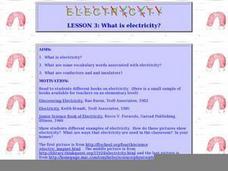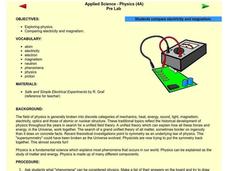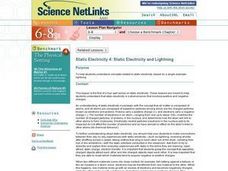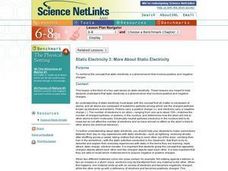Curated OER
Isotopes; Molecular Notation; Electron Orbits
In this isotopes, molecular notation, and electron orbits learning exercise, students read selections pertaining to isotopes, mass number, molecular notation, electric attraction, and electron orbits. In addition, students complete 11...
Curated OER
Isotopes
In this isotopes worksheet, students review mass number, molecular notation, electron attraction, and electron orbits. This worksheet has 5 matching and 5 short answer questions.
Curated OER
Atomic Structure
In this atomic structure learning exercise, students select answers to 8 fill in the blank questions on subatomic particles from the drop down box.
Curated OER
What Is Electricity?
Students investigate vocabulary words associated with electricity. In this electrical instructional activity, students utilize the Internet to research what electricity is and how it works. Students create an actual circuit in class...
Curated OER
Chemistry 1 Practice Exam
In this chemistry practice test worksheet, students answer 30 multiple choice questions regarding chemical formulas and chemical names for compounds.
Curated OER
Electricity and Circuits
In this electricity and circuits worksheet, students read a 2 page article, answer 5 questions with multiple choice answers and read 10 statements and determine if they are true or false.
Curated OER
Electricity and Magnetism
Fourth graders compare electricity and magnetism. In this science instructional activity, 4th graders discuss the concepts of electricity and magnetism and brainstorm examples of electrical and magnetic forces.
Curated OER
Structure of Matter
In this science puzzle worksheet, learners solve a crossword puzzle related to matter. For example, "Scientist who discovered protons."
Curated OER
Chapter 22 - 25 Review
In this chemistry review worksheet, students explore their knowledge of solutions, acid and bases, nuclear reactions, and radioactive decay as they answer 33 matching, fill in the blank, and short answer questions.
Curated OER
Elements of Chemistry: The Periodic Table
Students examine the atomic structure of elements. In this chemistry lesson plan students organize elements of the periodic table according to their atomic mass, and compare their order within the periodic table.
Curated OER
Magnetism
Students study magnetism. For this science lesson, students participate in an activity to discover how electrons in a magnet move. Students identify items around the classroom that are magnetic.
Curated OER
Answers for Elements and Compounds Crossword Puzzle
In this chemistry worksheet, students are provided with the answers to a 28 clue crossword puzzle about elements and compounds.
Curated OER
Water and Ice
Students observe water as it changes form. In this water lesson students observe, measure, and describe water as it changes state.
Curated OER
Static Electricity 4: Static Electricity and Lightning
Students explain concepts related to static electricity, based on a single example: lightning.
Curated OER
Static Electricity 3: More About Static Electricity
Students reinforce the concept that static electricity is a phenomenon that involves positive and negative charges.
Curated OER
Static Electricity
In this static electricity worksheet, students use balloons, flannel cloths, and a plastic bag to create static electricity. Students then fill out 3 tables and answer 3 short answer questions.
Curated OER
Electricity
Learners watch instructor present demonstrations of the basic principles of static electricity, and then conduct some of their own experiments. In small groups, students build simple circuits, using batteries, to try to light up a light...
Curated OER
Water and Ice
Students examine water. In this chemistry lesson plan, student examine the physical properties of water and how it changes from a liquid to a solid or a gas. This lesson plan contains links to a second and third complimentary lesson plan...
Curated OER
Amazing Water Changes
Students explore the properties of water and how it changes states. In this kindergarten to 2nd grade science lesson, students pair a hands-on science activity with two suggested books. This inquiry lesson has extension activities to...
Curated OER
Understanding Oxidation Numbers
Students review atomic numbers, positive and negative charges, and the periodic table. They examine the relationships among protons and electrons, location of various elements, electron energy levels, and oxidation numbers.
Curated OER
Advanced Paragraph Correction #8
In this paragraph correction instructional activity, students read an 8 line passage. Then students respond to 8 multiple choice questions regarding grammar, punctuation, and spelling errors within the paragraph.
Curated OER
Grade 9 Science Review
In this 9th grade science review activity, students complete 63 true or false questions on topics such as atomic notation, isotopes, covalent bonds, Ohm's law, and electric circuits.
Curated OER
The Life Cycle of a Star
In this stars worksheet, students read about the different stages in the life cycle of a star. Then students complete 3 short answer questions.
Curated OER
Periodic Table Lesson Plan
Students describe how elements are arranged on the periodic table. They compare metals, nonmetals, and metalloids based on their properties and on their locations in the periodic table. Students describe the differences between a...

























